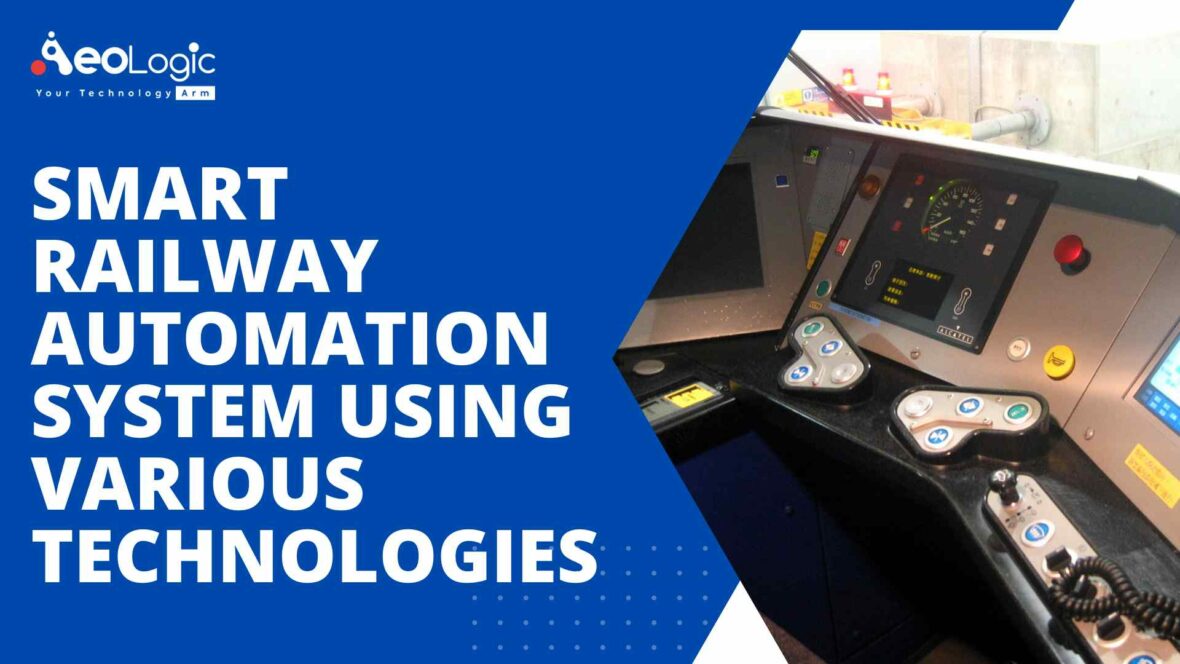Technology is the future and we are going through it. From Artificial Intelligence to Virtual Reality and many more, this world has seen so much advancement in the last few years. Rapid innovation in technology not only changes our lifestyle but also creates new jobs for us. They have come up with a Smart Railway Automation System which will be using various technologies that make it easier for the operation of railway vehicles on the network.
Railway is vital to any country’s transport system as it carries passengers and products to places. As railway systems grow bigger, they become more complicated and require better quality management. The increasing complexity of railway systems has led to an increase in maintenance costs which need to be optimized so that the system is efficient and safe.
Let’s begin!
Table of contents
- Overview
- What is an Automation System?
- Types of Automation Systems
- Smart Railway Automation using Various Technologies
- How Does a Smart Railway Automation System Work?
- Pros and Cons of a Smart Railway Automation System
- Conclusion
Overview
Railway automation is a critical component of modern rail systems. It allows for the safe, efficient operation of the railway network, and its implementation has allowed for the development of many new technologies. For example, many countries have started to use smart track technology to monitor the movement of trains on their network and to monitor the condition of tracks. The system monitors track conditions by sending data from each sensor to a central server, where it is analyzed by a machine-learning algorithm that learns from previous data and determines whether or not there is any damage. If there is damage, then it sends an alert to the train crew so they can take action in time.
Also see: Our RFID Solutions
What is an Automation System?
An automation system is a system that automates various processes. In the context of railway automation, this typically refers to automated train control, where various systems are used to automatically control the movement of trains. This can include trackside signals, in-cab signalling, and wayside systems such as Automatic Train Protection (ATP).
There are many benefits of using an automation system in railway operations. Automation can improve safety by reducing the potential for human error. It can also increase efficiency by allowing trains to run closer together and reducing the need for manual interventions. Automated systems can also help to improve service quality by providing a more consistent and reliable service.
There are a number of different technologies that can be used in an automated railway system. These include communications-based train control (CBTC), European Train Control System (ETCS), and Global Positioning System (GPS). each of these technologies has its own advantages and disadvantages, and the best solution for a particular railway will depend on a number of factors such as the type of operation, the geography, and the infrastructure.
Types of Automation Systems
- Automatic Train Control (ATC)
- Automatic Train Protection (ATP) system,
- And, Automatic Train Operation (ATO) system
There are many different types of automation systems that can be used in a railway system. The most common type is the Automatic Train Control (ATC) system, which is used to automatically control the movement of trains. Other types of automation systems include the Automatic Train Protection (ATP) system, which is used to prevent accidents, and the Automatic Train Operation (ATO) system, which is used to automatically operate trains.
Also Read: Why Is CRM Software a Game-changer When It Comes to Delivering Better Customer Experiences?
Smart Railway Automation using various technologies:
In this blog section, we’ll be discussing the multiple technologies used in an intelligent railway automation system. We’ll see how these technologies can be used to improve the efficiency and safety of railway operations.
Smart Railway Automation System using various technologies:
The smart railway system has the following features:
- Fixed-block signaling system
- Automatic train protection (ATP)
- Automatic train control (ATC)
- Digital signal communication (DSC)
- Equalizer and dynamic brake control (EDBC)
Track and Monitor: One of the most important aspects of an intelligent railway automation system is its ability to track and monitor trains. This can be done using GPS or other tracking devices. By tracking trains, the system can automatically route them around problems on the tracks, such as delays or accidents.
Control train speed: Another important aspect of a smart railway automation system is its ability to control train speed. This can help prevent accidents by ensuring that trains are always traveling at a safe speed. Speed control can also help save energy by reducing the need for braking and accelerating.
Boost your business performance with our automation solutions!
Signal systems: Communication is another key component of a smart railway automation system. By communicating with other parts of the system, such as signal systems and switches, the system can optimize routes and avoid problems. Communication can also be used to provide information to passengers, such as train schedules and arrival times. They are:
- Ethernet-based communication system.
- Bluetooth-based communication system.
- GSM/GPRS-based communication system.
Sensors: The use of sensors is also important in a smart railway automation system. Sensors can be used to detect obstacles on the tracks, such as fallen trees or debris.
Also Read: 10 Ways to Use Artificial Intelligence to Improve Business Processes
How Does a Smart Railway Automation System Work?
A smart railway automation system is a computerized system that uses various technologies to control and manage railway operations. These systems are designed to improve safety and efficiency while reducing costs.
The main components of a smart railway automation system include track circuits, sensors, switches, and signals. The track circuits are used to detect the presence of trains on the tracks and to route them accordingly. The sensors are used to monitor the speed and direction of trains, as well as track conditions. The switches are used to route trains onto the correct track. The signals are used to control the movements of trains.
Smart railway automation systems can be controlled remotely, or they can be automated to run independently. These systems can be used on any type of railway, from high-speed passenger railways to freight railways.
Also Read: The Role of AI in Education And Learning: Just Promises Or Revolution
Pros and Cons of a Smart Railway Automation System
There are many potential benefits to implementing a smart railway automation system. These benefits include increased safety, efficiency, and capacity.
The pros of having a smart railway automation system are:
- It is able to provide real-time information on train movements and other information that is relevant to the operations of the railway network.
- Also, it has the ability to connect with other systems such as PLCs, GPS units, and sensors.
- It can be used as a control center for other automated systems such as traffic lights or alarm systems.
- It can also be used for maintenance purposes such as fault detection or the location of parts within the network.
However, there are also some potential drawbacks to such a system. These drawbacks include the cost of implementation and the potential for disruptions during the transition to the new system.
The cons of having a smart railway automation system are:
- It may take some time to get used to.
- You need to invest money into it.
- The system is dependent on electricity and batteries. It means that if there is no power supply, it will not work.
Also Read: 10 Ways to Use Artificial Intelligence to Improve Business Processes
Conclusion
The Smart Railway Automation System is a unique and efficient way to automate various railway operations. By using various technologies, the Smart Railway Automation System can improve efficiency and safety while reducing costs.
The railway industry is working to incorporate predictive maintenance with Big Data. Recent improvements in sensor and condition monitoring technology have resulted in continuous data collecting and review, considerably reducing the quantity and expense of unplanned repairs.
If you are interested in elevating your businesses using technologies, connect with our industry experts at Aeologic Technologies.
Related Blogs:
- How AI/ML Can Change the Public Transportation Industry
- Transforming Business With Digital Technology in the Oil Palm Industry in India
- Importance of Digital Asset Management in the Retail Industry
- How AI is Transforming the Agriculture Industry
- 10 Ways to Use Artificial Intelligence to Improve Business Processes
- The Future of IoT Technology in Convenience Stores
- Building Manufacturing Resilience Through AI and ML






